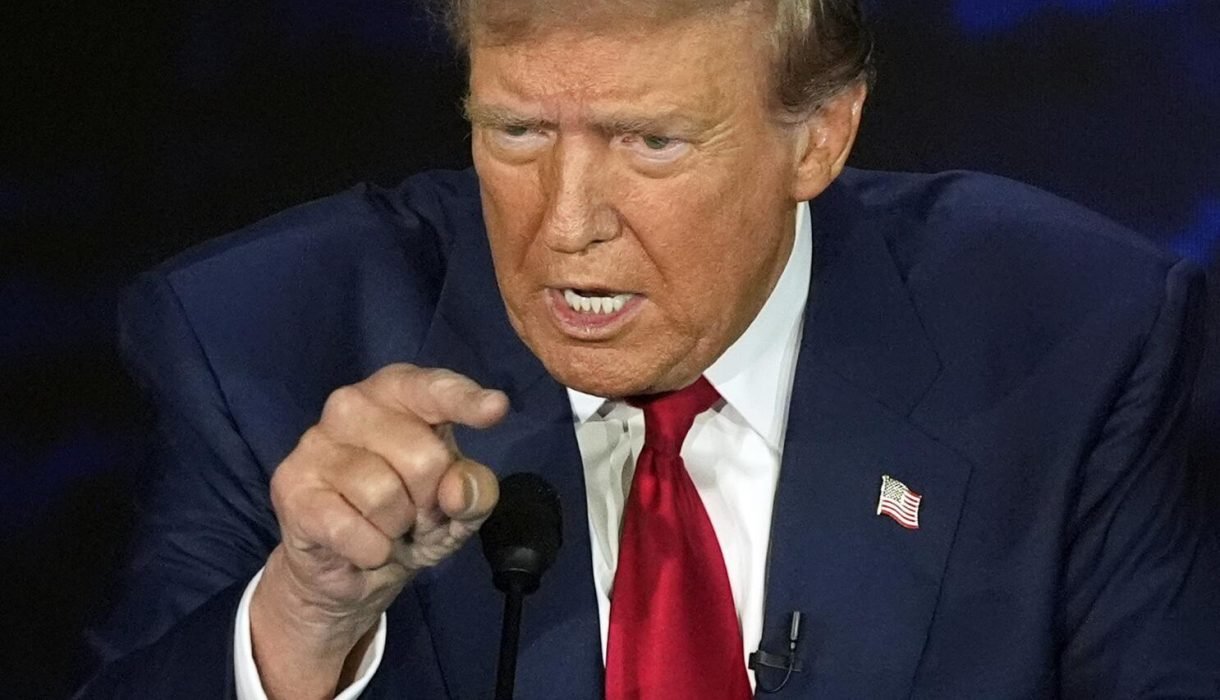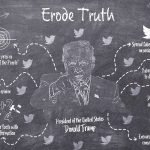
Unmasking the Truth: A Journey Through Trump’s Landscape of Falsehoods.
Posted in :
Donald Trump’s presidency has been characterized by a staggering volume of false statements, a tactic used to manipulate public perception and challenge democratic integrity, emphasizing the crucial role of truth in leadership.
The rampant spread of misinformation during Donald Trump’s presidency, examining its various categories, the strategies behind them, and the pressing implications for democracy, truth, and accountability in leadership.
As the first few months of the Trump administration unfolded, the American public faced an astonishing reality: a presidency marked not just by high-stakes policy debates but by an unprecedented barrage of false and misleading statements. In reflecting on conversations I had with friends during those tumultuous times, it became clear that many felt lost in a sea of conflicting narratives, questioning what to believe as the fabric of truth unraveled before their eyes. This post endeavors to peel back the layers of deception propagated by the former president, highlighting its implications not only for American politics but also for the very foundation of democratic values.
The Unprecedented Volume of Falsehoods
The presidency of Donald Trump has been marked by an astonishing amount of falsehoods. According to The Washington Post’s Fact Checker, he made a staggering total of 30,573 false or misleading statements during his four-year term. This figure is not just a number; it represents a significant shift in how political communication is conducted in the United States.
The Daily Average of Misinformation
To put this into perspective, Trump’s daily average of misinformation climbed dramatically. In his first year, he averaged about six false claims per day. By the end of his presidency, this number skyrocketed to 39 false claims per day. That’s a staggering increase! How did we get here? What does this mean for the political landscape?
- Year One: 6 false claims per day
- Year Four: 39 false claims per day
This escalation in falsehoods is unprecedented in American political history. It raises questions about the nature of truth in politics. Are we witnessing a new norm? Or is this an anomaly that will be corrected in future administrations?
Comparative Analysis with Past Leaders
When comparing these numbers to past U.S. leaders, the increase in misinformation is alarming. Previous presidents have certainly made false statements, but the sheer volume and frequency of Trump’s claims set a new standard. This isn’t just about quantity; it’s about the impact these statements have on public trust and democratic processes.
Fact-checking organizations have been crucial in documenting these falsehoods. They provide concrete data for analysis, allowing the public to see the extent of misinformation. Yet, despite their efforts, the challenge remains. How do you combat a firehose of falsehoods?
The Strategy Behind the Falsehoods
Analysts suggest that Trump’s pattern of misinformation is not accidental. It appears to be a deliberate strategy. By overwhelming the public with lies, he creates confusion. This diminishes the impact of factual reporting and allows him to control the narrative. It’s a tactic that mirrors propaganda techniques used to destabilize truth.
“Misinformation is a powerful tool in the arsenal of politics, and its normalization poses severe risks to democracy.” – Fact-Checking Expert
This normalization of falsehoods is troubling. It erodes public trust in institutions and hampers informed decision-making. When leaders frequently disseminate misinformation without accountability, it sets a dangerous precedent. What does this mean for the future of democracy?
Implications for Democracy
The implications of this unprecedented volume of falsehoods are profound. It polarizes society and undermines the foundations of democratic governance. The normalization of lies in political discourse can lead to a society where truth is subjective. This is a slippery slope.
Addressing this issue requires a collective commitment to truth and critical thinking. It also necessitates the reinforcement of journalistic integrity. The role of fact-checkers is more important than ever. They are the guardians of truth in an era where misinformation reigns.
Trump’s presidency has witnessed a continuous and alarming pattern of misinformation. This challenges the previous norms of political communication. As society grapples with these changes, the need for accountability and truth in leadership becomes increasingly clear.
Categories of Misinformation: A Focused Exploration
The presidency of Donald Trump has been marked by a significant amount of misinformation. This falsehoods have not only misled the public but also served as tools for political agendas. Three main categories stand out: election integrity, public health during the COVID-19 pandemic, and immigration rhetoric. Each of these areas has profound implications for society.
Election Integrity
One of the most prominent false narratives propagated by Trump is the claim that the 2020 presidential election was stolen. Despite numerous court rulings and investigations confirming the election’s integrity, Trump has continued to assert that fraud occurred. This narrative has serious consequences. It undermines public trust in democratic processes. When a significant portion of the population believes that their votes do not count, democracy itself is at risk.
Trump’s insistence on this falsehood has led to widespread confusion. Many people are left questioning the legitimacy of elections. This is not just a political issue; it’s a matter of civic responsibility. As a political analyst noted,
“When leaders manipulate facts on such a scale, we must question our standards for truth in governance.”
COVID-19 Pandemic
During the COVID-19 pandemic, misinformation reached alarming levels. Trump made several misleading statements about the virus’s severity, treatment options, and preventive measures. For instance, he promoted unproven treatments and downplayed the virus’s risks. This behavior had real-world consequences. It affected public health responses and people’s perceptions of safety measures.
- Many individuals resisted health guidelines.
- Public confusion grew regarding the virus’s seriousness.
- Trust in health authorities diminished.
Such misinformation can lead to dangerous outcomes. When leaders fail to provide accurate information, they jeopardize public health. The consequences of misinformation during a health crisis can be dire, affecting lives and livelihoods.
Immigration Rhetoric
Trump’s rhetoric on immigration has also been fraught with misinformation. He has frequently exaggerated or fabricated claims about immigrants, suggesting that they bring crime and instability. This narrative exploits fears about criminality and borders. It paints a distorted picture of immigrant communities.
Such statements have fueled divisive policies and rhetoric. They have created an environment where immigrants are viewed with suspicion. This not only harms individuals but also fractures societal cohesion. The impact of this misinformation extends beyond politics; it affects families and communities.
Political Agendas Behind Misinformation
Each of these categories serves as a vehicle for political agendas. Misinformation is not merely incidental; it is often a deliberate strategy. By overwhelming the public with a “firehose of falsehoods,” leaders can create confusion. This diminishes the impact of factual reporting and maintains control over the narrative.
Survey responses illustrate the public confusion resulting from Trump’s misleading statements. Many people struggle to discern fact from fiction. This confusion can lead to apathy or, worse, blind allegiance to false narratives.
In conclusion, misinformation about election integrity, public health, and immigration has significant consequences for public perception and policy. It erodes trust in institutions and hampers informed decision-making. The normalization of falsehoods in political discourse poses a serious threat to democracy itself.
The Impact of Misinformation on Democracy and Public Trust
Misinformation has become a significant threat to democracy. It erodes public trust in democratic institutions. When citizens are bombarded with falsehoods, they begin to question the very foundations of their governance. This is not just a minor issue; it’s a crisis that affects everyone.
The Erosion of Trust
Public trust is essential for democracy to function. When leaders consistently spread falsehoods, it creates a ripple effect. Citizens start to doubt not only the statements made by their leaders but also the institutions that uphold democracy. This erosion of trust can lead to a dangerous cycle of skepticism.
- Consistent falsehoods: When lies become the norm, the truth is often overshadowed.
- Questioning institutions: Citizens may begin to see democratic institutions as unreliable.
As a result, the very fabric of democracy begins to fray. The quote from a democracy advocate resonates deeply:
“In democracy, the truth should not be up for debate; yet here we are, questioning our very sources of truth.”
Misinformation and Decision-Making
Misinformation complicates informed decision-making among citizens. When people are faced with conflicting information, it becomes challenging to discern what is true. This overload of information can lead to confusion. How can one make an informed choice when the truth feels like just another option to weigh?
- Information overload: Too much information can paralyze decision-making.
- Confusion: Citizens may feel lost in a sea of conflicting narratives.
This confusion can lead to disengagement. When people feel overwhelmed, they may choose to ignore the information altogether. This disengagement is dangerous. It allows misinformation to thrive unchecked.
The Psychological Effects of Misinformation
The psychological effects of misinformation are profound. When individuals are constantly exposed to falsehoods, it can lead to a sense of helplessness. They may feel that no matter how hard they try to seek the truth, they are met with a barrage of lies. This can create a feeling of fatigue.
What happens when the truth feels like just another option? It diminishes the value of truth itself. People may start to believe that all information is equally valid, regardless of its source. This is a dangerous mindset that can lead to polarization.
- Fatigue: Constant exposure to misinformation can lead to mental exhaustion.
- Polarization: Distrust can create divisions within society.
As trust erodes, society becomes more polarized. This polarization can lead to societal unrest. When people no longer trust each other or their institutions, it creates an environment ripe for conflict.
Broader Implications
The broader implications of consistently unchallenged falsehoods extend beyond politics. They infiltrate society at large, creating an environment of distrust and confusion. This confusion can have real-world consequences. It can affect everything from public health to community relations.
In conclusion, misinformation poses a significant threat to democracy and public trust. It erodes the foundations of informed citizenship and creates a society where truth is subjective. Addressing this issue requires a collective effort to prioritize truth and accountability in all aspects of public life.
Navigating the Landscape of Truth: The Role of Fact-Checking
In an era where misinformation spreads like wildfire, the role of fact-checking organizations has never been more critical. During Donald Trump’s presidency, the sheer volume of falsehoods presented a unique challenge. Fact-checkers stepped up to the plate, aiming to restore trust in the truth. Their mission was clear: to sift through the noise and provide clarity.
The Mission and Impact of Fact-Checking Organizations
Fact-checking organizations like PolitiFact, FactCheck.org, and The Washington Post’s Fact Checker have been at the forefront of this battle. They have dedicated countless hours to verifying claims made by public figures. During Trump’s presidency, these organizations documented an astonishing number of false or misleading statements. According to reports, Trump made over 30,000 false claims during his time in office. This staggering figure averages out to about 21 falsehoods per day. Can you imagine the impact of such a relentless barrage of misinformation?
These organizations not only highlight false claims but also provide context. They help the public understand the implications of these statements. For instance, when Trump claimed that the 2020 election was stolen, fact-checkers were quick to debunk this narrative. They pointed to court rulings and investigations that confirmed the election’s integrity. This kind of accountability is essential for a healthy democracy.
Tools and Resources for Verification
In addition to their investigative work, fact-checkers offer tools and resources for individuals. These resources empower citizens to verify claims on their own. Websites like Snopes and various fact-checking apps allow users to quickly check the validity of statements. This is crucial in facilitating informed conversations. When people have access to accurate information, they can engage in discussions based on facts rather than fiction.
Moreover, social media platforms have begun to incorporate fact-checking features. They flag misleading posts and provide links to verified information. This is a step in the right direction, but it’s not foolproof. The challenge remains: how do we ensure that the public engages with these resources? The answer lies in education and awareness.
Challenges Faced by Fact-Checkers
Despite their best efforts, fact-checkers face significant challenges. The volume of misinformation is overwhelming. With Trump averaging six falsehoods per day in his first year and escalating to 39 in his final year, it’s a daunting task to keep up. The constant flow of false claims can drown out factual reporting. This creates a cycle where misinformation thrives.
Moreover, public engagement with fact-checking resources varies widely. Some individuals actively seek out this information, while others dismiss it. This disparity affects the overall success of fact-checking efforts. As one fact-checker aptly stated,
“The fight against misinformation isn’t just about facts; it’s about restoring public trust in truth itself.”
This highlights the deeper issue at play: the need for a collective commitment to truth.
In assessing the effectiveness of fact-checking organizations, it becomes evident that accountability is key in this struggle for truth against a barrage of falsehoods. The mission of these organizations is not just to correct the record but to foster a culture of truthfulness. As society grapples with the implications of misinformation, the role of fact-checkers will continue to be vital. They serve as a beacon of hope in a landscape often clouded by deceit. By supporting these efforts and utilizing available resources, individuals can contribute to a more informed and truthful public discourse.
TL;DR: Donald Trump’s presidency has been characterized by a staggering volume of false statements, a tactic used to manipulate public perception and challenge democratic integrity, emphasizing the crucial role of truth in leadership.
ElectionIntegrityClaims, Fact-checkingOrganizations, COVID-19Misinformation, TrumpMisinformation, ImmigrationExaggerations, PresidentialFalsehoods, DemocracyAndTruth, PoliticalAccountability, LeadershipAndTransparency
ElectionIntegrityClaims, #TrumpMisinformation, #Fact-checkingOrganizations, #LeadershipAndTransparency, #COVID-19Misinformation, #ImmigrationExaggerations, #PresidentialFalsehoods, #PoliticalAccountability, #DemocracyAndTruth,#TrumpLies, #Misinformation, #FactChecking, #Democracy, #PublicTrust, #MediaIntegrity, #Disinformation, #PoliticalTruth

